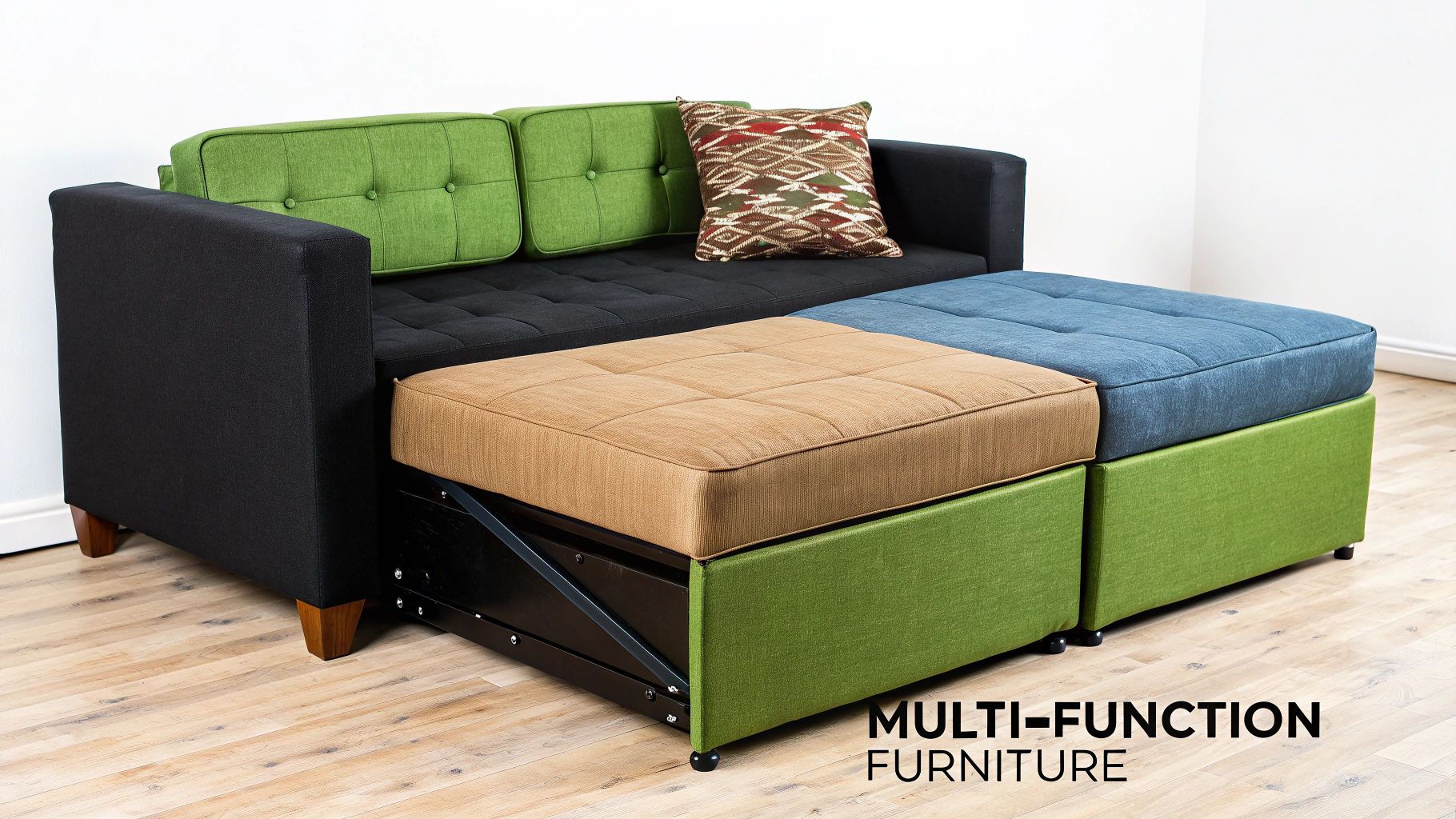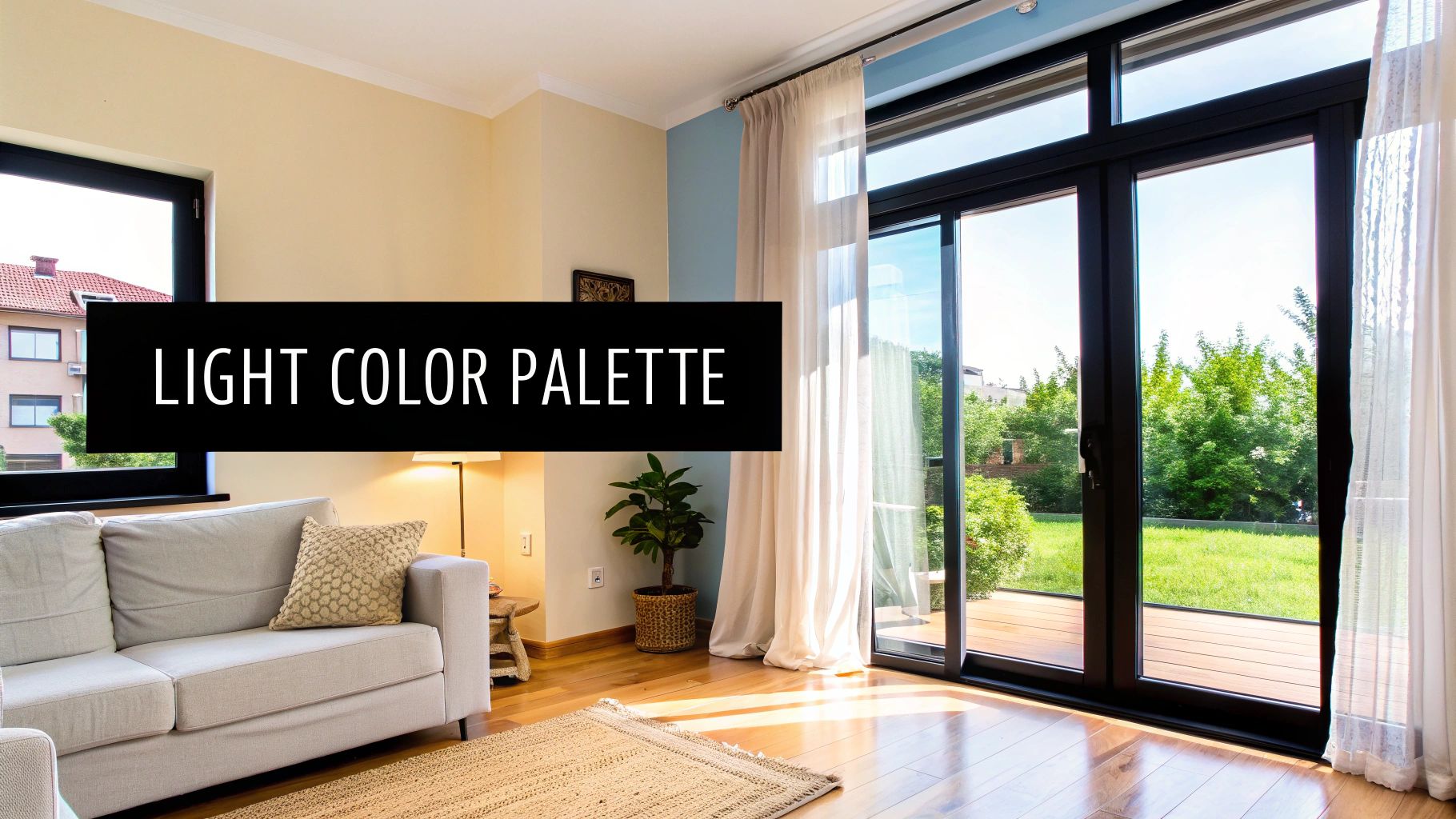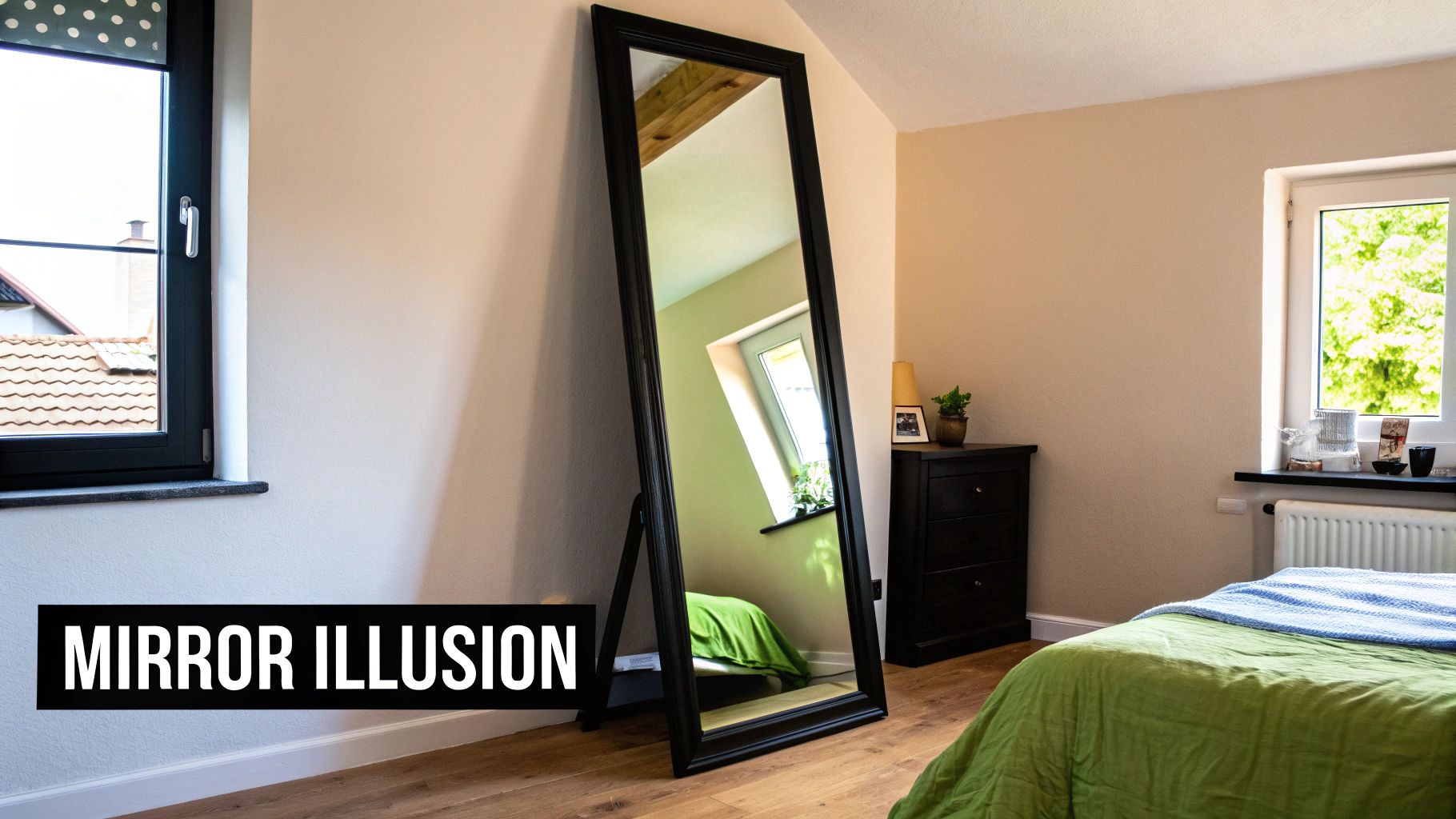7 Genius Small Apartment Decorating Ideas for 2025

Living in a small apartment doesn't mean compromising on style or comfort. In fact, compact spaces present a unique opportunity for clever, creative, and highly personalised design. The challenge is to make every square metre count, transforming limitations into stunning features that reflect your lifestyle. This guide moves beyond generic advice to offer a curated collection of practical and innovative small apartment decorating ideas. These strategies will help you maximise your space, enhance its functionality, and create a home that feels both expansive and uniquely yours.
We will explore actionable techniques that deliver tangible results. From harnessing vertical space with smart storage to selecting multi-functional furniture that works harder, each idea is designed for immediate implementation. You will learn how to strategically use light colour palettes and mirrors to create an illusion of depth, and how to define distinct zones within an open-plan layout using clever dividers and thoughtful furniture placement.
Whether you're styling a studio in Auckland, a cosy flat in Wellington, or any compact home across New Zealand and Australia, these tips are universally applicable. Forget the clutter and the cramped feeling; it's time to realise the full potential of your home. This article provides the blueprint to craft a beautiful, organised, and supremely liveable space, no matter its size. We will delve into specific examples, showing you exactly how to implement these concepts to unlock your apartment's true character and capability.
1. Idea 1: Think Vertically - Maximise Your Wall Real Estate
When your floor plan is limited, the most effective strategy is to look up. Thinking vertically is a cornerstone of brilliant small apartment decorating ideas, turning often-neglected wall space into a highly functional and visually appealing feature. This approach involves utilising the full height of your room to draw the eye upward, which cleverly creates an illusion of a larger, more open space.
By shifting storage from the floor to the walls, you reclaim precious square metres. This not only declutters your living area but also makes it feel significantly more spacious and organised. It’s about being strategic with your vertical planes to build a home that is both practical and stylish.

Why This Approach Works
Vertical design works because it fundamentally alters the perception of a room's dimensions. Tall, slender furniture and floor-to-ceiling shelving guide the gaze upwards, emphasising the room's height rather than its limited footprint. This visual trick is incredibly effective in studio apartments, narrow living rooms, or any compact area where traditional, bulky furniture would feel overwhelming.
This concept has been popularised by organisational experts and design-forward companies like IKEA and The Container Store, who champion smart, space-efficient living. It moves beyond just adding a single shelf; it’s about creating a comprehensive storage system that integrates seamlessly into your home's aesthetic.
Key Insight: Vertical storage doesn't just add space; it reshapes the perceived volume of a room, making it feel taller and more expansive than it actually is.
Actionable Tips for Implementation
To make the most of your vertical real estate, consider these practical tips:
- Go Floor-to-Ceiling: Install shelving units that extend as high as possible. This maximises storage capacity and creates a strong, clean vertical line. Systems like IKEA's IVAR or custom built-ins are perfect for achieving this look.
- Choose Light Colours: Opt for shelving in white, light grey, or natural wood tones. Lighter colours reduce visual weight, preventing tall units from appearing bulky or oppressive in a small space.
- Mix It Up: Combine open shelves for displaying décor and books with closed cabinets or drawers to hide clutter. This creates a balanced, visually interesting wall that is both beautiful and practical.
- Secure Everything: Safety is paramount. Always secure tall or wall-mounted furniture to wall studs to prevent tipping, especially in homes with children or pets.
- Prioritise Access: A well-organised vertical system is an accessible one. Place items you use daily at eye level, less-frequently used items higher up, and seasonal or archival items on the very top shelves.
2. Embrace Multi-Functional Furniture - Make Every Piece Work Harder
In a small apartment, every piece of furniture must justify its existence. Multi-functional furniture is one of the most intelligent and impactful small apartment decorating ideas because it allows a single item to serve multiple purposes. This strategy is about maximising functionality without sacrificing valuable floor space, transforming your home into a versatile and highly efficient living environment.
A storage ottoman can serve as a footrest, extra seating, and a place to hide blankets, while a sofa bed instantly turns your living room into a guest room. By investing in pieces that are both clever and stylish, you can significantly reduce clutter and create a home that adapts to your needs, whether you're working, relaxing, or entertaining guests.

Why This Approach Works
The genius of multi-functional furniture lies in its ability to consolidate needs, reducing the total number of items required in a room. Instead of needing a separate coffee table, storage chest, and seating, a single storage ottoman accomplishes all three. This minimalist approach directly combats the clutter that can make a compact space feel cramped and chaotic.
This design philosophy has been championed by innovators like Resource Furniture, with their incredible transforming wall beds, and popularised by design-forward brands such as West Elm and CB2. It’s a core tenet of the tiny house movement, where every centimetre counts. The goal is to choose fewer, better pieces that offer maximum utility and flexibility.
Key Insight: Multi-functional furniture isn’t just about saving space; it’s about creating a dynamic living environment that can be reconfigured in moments to suit different activities.
Actionable Tips for Implementation
To successfully integrate multi-functional pieces into your apartment, focus on quality and practicality:
- Prioritise High-Traffic Pieces: For items you'll use daily, like a sofa bed or an expandable dining table, invest in high-quality mechanisms and durable materials. This ensures longevity and smooth operation.
- Measure Everything Meticulously: Before buying, measure not only the space where the furniture will go but also all doorways, lifts, and stairwells. Ensure the piece can fit in both its compact and expanded forms.
- Look for Hidden Storage: Opt for pieces with clever, integrated storage. A bed frame with built-in drawers, a coffee table that lifts to reveal a hidden compartment, or a sectional with storage in the chaise can make a huge difference. For example, adding storage cushions can be an easy way to achieve this, and you can learn more about decorating with cushions on maakhome.co.nz.
- Assess Your True Needs: Choose furniture that aligns with your primary activities. If you work from home, a console table that doubles as a desk might be perfect. If you love hosting, an expandable dining table is a must-have.
- Test for Comfort: If a piece serves as seating or a bed, comfort is non-negotiable. Always test a sofa bed in person if possible, or read extensive reviews to ensure it will be comfortable for you and your guests.
3. Light Colour Palette - Harness the Power of Brightness
One of the most powerful and enduring small apartment decorating ideas is the strategic use of a light colour palette. Embracing whites, creams, soft greys, and pale pastels as your foundation can dramatically alter the perception of a space. These colours are exceptional at reflecting natural and artificial light, which makes a room feel more open, airy, and significantly larger than its actual dimensions.
A light palette serves as a blank canvas, allowing other design elements to stand out without overwhelming the space. It’s a technique that creates a serene and uncluttered atmosphere, making your home a more peaceful and inviting retreat from the bustle of city life. This approach isn't about creating a sterile environment; it's about building a bright, expansive-feeling base.

Why This Approach Works
The effectiveness of a light colour palette lies in basic principles of light and perception. Darker colours absorb light, which can make a room feel enclosed and smaller. In contrast, light colours bounce light around the room, creating an illusion of depth and openness. This visual expansion is a game-changer in compact living areas, where every square metre counts.
This principle has been championed by the Scandinavian design movement, which prioritises brightness to combat long, dark winters, and popularised by minimalism advocates and organisational experts like Marie Kondo. The goal is to create a visually clean, cohesive look that reduces visual noise and promotes a sense of calm and order, which is essential for comfortable small-space living.
Key Insight: A light colour scheme doesn’t just brighten a room; it actively works to push the walls back visually, creating a more expansive and breathable living environment.
Actionable Tips for Implementation
To implement a light colour palette effectively, consider these practical tips:
- Layer Tones and Textures: To prevent an all-white or neutral space from feeling flat or clinical, introduce a variety of textures. Think woollen throws, linen cushions, timber accents, and jute rugs. This adds warmth, depth, and character.
- Use Varying Shades: Stick to a light colour family but use different shades to create subtle contrast and dimension. For instance, combine crisp white walls with off-white furniture and soft grey textiles for a sophisticated, layered look. You can find more inspiration on how to work with a neutral colour scheme.
- Incorporate Natural Elements: Add houseplants, fresh flowers, or timber furniture to introduce natural colour and life. Greenery provides a beautiful contrast against a light backdrop and helps purify the air.
- Choose Strategic Accent Colours: A light palette doesn’t mean no colour. Select one or two accent colours for personality. Use them sparingly in items like cushions, artwork, or a single statement piece of furniture to create focal points.
- Amplify with Lighting: Ensure your space has adequate lighting to complement the light colours. A poorly lit neutral room can feel cold. Use a mix of overhead, task, and ambient lighting to create a warm and welcoming glow.
4. Strategic Mirror Placement
One of the most classic and effective small apartment decorating ideas is the strategic use of mirrors. This is more than just hanging a mirror to check your reflection; it's a powerful design tool that can visually double your space, amplify light, and add a layer of sophistication. By carefully positioning mirrors, you can trick the eye, making a cramped room feel expansive and a dark corner feel bright and welcoming.
The principle is simple: mirrors reflect both light and the view, creating an illusion of depth and openness. Placing a large mirror on a key wall can have the same impact as adding another window, instantly transforming the atmosphere of the room. It’s a technique celebrated in design history, from traditional French interiors to the glamour of Hollywood Regency, for its ability to create drama and elegance.

Why This Approach Works
Strategic mirror placement works by manipulating perception. When a mirror reflects a light source, like a window or a lamp, it scatters that light around the room, making the entire area feel brighter and more airy. Similarly, when it reflects a large portion of the room or an open doorway, it creates a sense of continuity, fooling the brain into perceiving a larger area than what physically exists.
This technique has been championed by renowned designers like Kelly Wearstler and Jonathan Adler, who use oversized and uniquely framed mirrors as statement pieces. In a small space, a large-scale mirror is particularly effective. For instance, a floor-to-ceiling mirror in a narrow hallway can make the constricted space feel twice as wide, while a mirrored splashback in a small kitchen adds depth and a touch of modern glamour.
Key Insight: A mirror doesn't just reflect space; it multiplies it. Strategic placement can artificially create new sightlines and light sources, fundamentally altering a room's perceived dimensions.
Actionable Tips for Implementation
To harness the space-enhancing power of mirrors, consider these practical tips:
- Position Opposite a Window: This is the golden rule. Placing a large mirror directly opposite a window will capture the maximum amount of natural light and reflect the outdoor view, effectively bringing the outside in.
- Go Big for Impact: In most cases, one large mirror is more effective than a collection of smaller ones. A large leaning floor mirror in a living room or bedroom creates a strong focal point and delivers the greatest spatial illusion.
- Be Mindful of Reflections: Always consider what your mirror will reflect. Avoid placing it where it will showcase clutter, a blank wall, or an undesirable view. Instead, have it reflect a beautiful piece of art, a plant, or an architectural feature.
- Use Mirrored Furniture: For a more subtle approach, incorporate mirrored furniture. A mirrored coffee table, side table, or wardrobe can add a sense of openness without dominating the wall space, as they appear to recede into the room.
- Create a Mirrored Feature Wall: In a dining nook or entryway, consider creating a gallery wall of antique or uniquely shaped mirrors. This serves as both a space enhancer and a captivating decorative feature.
5. Open Shelving Systems
Embracing open shelving is a transformative step among small apartment decorating ideas, replacing bulky, visually heavy closed cabinets with an airy, accessible alternative. This design choice opens up a room by reducing visual mass, making spaces like kitchens, bathrooms, and living areas feel larger and brighter. It turns everyday storage into a curated display, blending functionality with personal style.
This approach allows you to showcase beautiful dishware, treasured books, or collected décor, infusing your personality directly into the room's fabric. By keeping essentials visible and within easy reach, open shelving also streamlines daily routines, making it a practical and aesthetically pleasing solution for compact living.
Why This Approach Works
The effectiveness of open shelving lies in its ability to create visual depth and reduce confinement. Unlike solid cabinet doors that create a hard stop for the eye, open shelves allow you to see through to the wall, making the room feel more expansive. This principle is especially impactful in small kitchens or narrow hallways where traditional cabinetry can feel oppressive.
This concept has been widely popularised by design movements that prioritise light and function, such as Scandinavian minimalism and the modern farmhouse aesthetic championed by figures like Joanna Gaines. It's about a conscious choice to live with less clutter and celebrate the beauty of well-organised, functional items.
Key Insight: Open shelving eliminates visual barriers, creating an illusion of greater space and turning functional storage into a personalised decorative feature.
Actionable Tips for Implementation
To successfully incorporate open shelving into your small apartment, focus on curation and organisation:
- Curate with Purpose: Be selective about what you display. Group items by colour, material, or theme for a cohesive, intentional look. A stack of all-white plates looks more organised than a mix of mismatched ones.
- Balance Form and Function: Mix functional items (like glasses and bowls) with decorative objects (like small plants, art, or vases). This balance prevents shelves from looking like pure storage and adds visual interest. This technique can complement other creative touches, like those found in these DIY wall art ideas.
- Leave Breathing Room: Avoid cramming shelves full. White space is crucial for achieving an uncluttered, airy aesthetic. Leave some space between groupings to let each item stand out.
- Contain the Small Stuff: Use stylish baskets, bins, or jars to wrangle smaller, less sightly items. This keeps clutter hidden while maintaining the open, organised feel of the shelves.
- Ensure Proper Support: Always install shelves securely into wall studs, especially when they will hold heavy items like dishes or books. Use a level to ensure they are perfectly straight for a professional finish.
6. Room Dividers and Zones - Create Harmony in Open-Plan Living
In studio apartments or open-plan layouts, the lack of walls can make a single room feel chaotic and undefined. This is where the strategic use of room dividers and zoning becomes one of the most powerful small apartment decorating ideas. The goal is to create distinct, functional areas for living, sleeping, and working, bringing order and purpose to your space without building permanent walls.
This technique is about more than just physical separation; it’s about using visual cues to signal a shift in function. By cleverly arranging furniture, using rugs, or introducing semi-permanent screens, you can craft a home that feels multi-layered and organised, even within a single, continuous area.
Why This Approach Works
Zoning works by providing psychological boundaries. When you visually separate your sleeping area from your workspace, it helps your brain switch off from work mode at the end of the day. This concept is a cornerstone of modern loft conversions and the tiny house movement, where maximising the utility of every square metre is paramount. It borrows heavily from Japanese interior design principles, which favour flexible, multi-functional spaces defined by lightweight screens.
Dividers like open-backed shelving units (such as IKEA's KALLAX) are particularly effective because they define a zone while also providing much-needed storage and maintaining a sense of openness. They create separation without completely blocking light or sightlines, which is crucial for making a small apartment feel airy and connected.
Key Insight: Creating zones doesn't shrink your space; it multiplies its functionality, allowing a single room to serve the purpose of three or four distinct areas.
Actionable Tips for Implementation
To successfully divide and conquer your small apartment, try these practical zoning strategies:
- Use Furniture as Dividers: Position a sofa with its back to your dining area to create a clear boundary for the living zone. An open bookshelf can elegantly separate a bed from a home office area, offering storage and a sense of privacy.
- Define with Rugs: Place a large rug in your living area and a different one under your dining table. This simple visual cue anchors each zone and clearly delineates its boundaries without adding any physical obstructions.
- Embrace Screens and Curtains: A stylish folding screen can be deployed to hide a messy desk or create a temporary guest nook. For a softer approach, ceiling-mounted curtain tracks allow you to draw a fabric divider across a room, offering flexibility and texture. Learn more about using a folding screen room divider on maakhome.co.nz.
- Leverage Lighting: Use different types of lighting for each zone. Bright, focused task lighting for a work area, warm ambient lamps in the living zone, and soft, dimmable light in the sleeping area will reinforce the purpose of each space.
- Go Green: Use a series of tall plants or a hanging plant installation to create a "living" wall. This natural divider adds life and colour while subtly separating spaces.
7. Built-in Storage Solutions
For the ultimate in space optimisation, nothing beats integrating storage directly into the architecture of your apartment. Built-in solutions are one of the most sophisticated small apartment decorating ideas, creating a seamless, uncluttered look that makes a space feel custom-designed and intentional. This approach involves creating storage that becomes part of the walls, nooks, and otherwise unused corners of your home.
Unlike freestanding furniture, built-ins utilise every available centimetre, from awkward alcoves to the space under a window. The result is a highly efficient, streamlined environment where storage disappears into the background, allowing your living areas to feel open, organised, and significantly larger.
Why This Approach Works
Built-in storage works because it eliminates the visual and physical clutter of separate furniture pieces. By matching the style and colour of your walls, these installations blend in perfectly, creating clean lines and an uninterrupted flow. This is particularly effective in small or irregularly shaped rooms where standard furniture would create awkward gaps or protrude into valuable circulation space.
This concept has been perfected by brands like California Closets and is a hallmark of Scandinavian design and the tiny house movement, where maximising function within a minimal footprint is paramount. The goal is to make storage an inherent feature of the home, not an afterthought, resulting in a clean, high-end aesthetic.
Key Insight: Built-in storage doesn't just add space; it enhances the architectural character of a room, providing a permanent and cohesive solution to clutter.
Actionable Tips for Implementation
To implement built-in solutions effectively, consider these practical tips:
- Maximise Awkward Spaces: Identify underutilised areas like the space under stairs, the alcove beside a fireplace, or the wall above a doorway. These are perfect candidates for custom shelves, cabinets, or even a compact built-in desk.
- Create a Window Seat: A classic built-in, a window seat with integrated drawers or a lift-up top provides both cosy seating and a significant amount of hidden storage. It’s a perfect addition to a living room or bedroom.
- Go Custom with Wardrobes: Floor-to-ceiling built-in wardrobes make the most of your bedroom's vertical space. Design the interior with a mix of hanging rails, shelves, and drawers tailored precisely to your clothing collection.
- Plan for the Future: Since built-ins are a permanent fixture, design them with long-term needs in mind. Opt for adjustable shelving and a versatile layout that can adapt as your storage requirements change over time.
- Ensure Proper Lighting: Integrated lighting, such as LED strips or puck lights within shelving units and wardrobes, is crucial. It adds a touch of luxury and makes the storage far more functional and easy to navigate.
7 Key Small Apartment Decorating Ideas Comparison
| Storage Solution | Implementation Complexity 🔄 | Resource Requirements ⚡ | Expected Outcomes 📊 | Ideal Use Cases 💡 | Key Advantages ⭐ |
|---|---|---|---|---|---|
| Vertical Storage Solutions | Medium - may need professional install | Moderate - shelving, mounting hardware | High - maximizes vertical space and room height illusion | Studio apartments, open layouts | Maximizes space without floor use; organized & accessible |
| Multi-Functional Furniture | Medium to High - design & quality focused | Moderate to High - specialized furniture | High - space saved by dual-function pieces | Small apartments, multipurpose rooms | Reduces clutter; flexible for activities |
| Light Color Palette | Low - painting and decor choice | Low - mostly paint and textiles | Medium to High - enhances brightness and spacious feel | All small spaces needing brightness | Makes rooms appear larger and airy; versatile backdrop |
| Strategic Mirror Placement | Low to Medium - installation varies | Low to Moderate - mirrors and mounts | High - space illusion and light amplification | Dark or small rooms needing brightness | Doubles perceived space; relatively inexpensive |
| Open Shelving Systems | Low to Medium - easy install & adapt | Low to Moderate - shelving materials | Medium - visually open storage, accessible display | Kitchens, bathrooms, living areas | Creates openness; affordable and adaptable |
| Room Dividers and Zones | Medium - furniture & divider setup | Low to Moderate - dividers or furniture | Medium - defines spaces, adds privacy and function zones | Studios, open-plan, multifunctional rooms | Creates privacy; flexible and organized zones |
| Built-in Storage Solutions | High - custom design & installation | High - custom carpentry and materials | Very High - seamless, space-maximizing, adds property value | Renovations, permanent space optimization | Maximizes awkward spaces; custom & durable |
Your Apartment, Reimagined
Navigating the unique challenges of a compact living area is not about restriction; it's a creative exercise in optimisation and personal expression. Throughout this guide, we have explored a collection of powerful small apartment decorating ideas, each designed to unlock the hidden potential within your home. The journey from feeling cramped to feeling comfortable and curated is paved with intentional choices, smart strategies, and a new way of seeing your space. It's about moving beyond the perceived limitations of square metres and embracing the possibilities that clever design can offer.
The core principle that ties all these concepts together is efficiency. This isn't just about saving space; it's about making every element of your apartment work harder and smarter for you. You don't just own a coffee table; you own a storage unit with a surface. You don't just have walls; you have vertical real estate ready for high-reaching shelves and art that draws the eye upward. This shift in perspective is the most crucial takeaway.
From Theory to a Transformed Reality
Let's distill the transformative power of the ideas we've covered. Realising the full potential of your apartment means understanding how these strategies work in synergy.
- Embracing the Third Dimension: The power of vertical storage solutions and open shelving systems cannot be overstated. By drawing the eye upward, you create an illusion of height and volume, making the entire room feel larger while decluttering floor space. This is a fundamental principle for any compact home.
- The Philosophy of Dual-Purpose Design: Multi-functional furniture is the cornerstone of modern small-space living. An ottoman that stores blankets, a dining table that doubles as a desk, or a sofa bed that welcomes guests without demanding a dedicated room are no longer just clever hacks; they are essential components of a functional, adaptable home.
- Harnessing Light and Reflection: The strategic use of a light colour palette and mirror placement are perhaps the most impactful yet simple changes you can make. Light colours create an airy, open atmosphere, while mirrors act as "windows," bouncing light and reflecting views to manufacture a sense of depth and expansiveness.
- Defining Your Domain: In a studio or small one-bedroom apartment, creating distinct areas is vital for a sense of order and peace. Room dividers and thoughtful furniture placement allow you to delineate zones for living, working, and resting, transforming a single room into a multi-faceted, organised environment.
Your Action Plan for a Better Space
Feeling inspired is one thing; taking action is another. The best approach is to start small and build momentum. Don't feel pressured to overhaul your entire apartment overnight. Instead, select one or two ideas from this article that resonate most strongly with your current frustrations or aspirations.
Is your living room floor cluttered? Focus on implementing a vertical storage solution first. Does your space feel dark and enclosed? Start by sourcing a large, statement mirror and observe the immediate difference it makes. By tackling one challenge at a time, you make the process manageable and rewarding, creating a positive feedback loop that encourages further improvements.
Ultimately, mastering these small apartment decorating ideas empowers you to take control of your environment. Your home should be a sanctuary, a place that supports your lifestyle, reflects your personality, and brings you joy. A smaller footprint does not mean you have to compromise on style, comfort, or functionality. It simply means you get to be more creative, more intentional, and ultimately, more innovative in how you define what "home" means to you. Your apartment, reimagined, is not just a decorated space; it's a testament to smart design and a celebration of living well, no matter the size.
Ready to make a bold statement, even in a small space? A stunning custom wall mural or unique wallpaper can become the focal point of your room, and Maak Home specialises in creating bespoke wall coverings right here in New Zealand. Explore their extensive gallery or upload your own design to transform a plain wall into a masterpiece at Maak Home.









